Online (Internet) Business Stats and Facts in 2023

The online world is now more populated than ever due to the SARS-COV-2 pandemic. We’ve witnessed the biggest shut-in that has occurred in decades. Now, the only difference is that we have access to the world wide web to keep us entertained.
The internet is crawling with all kinds of businesses. Truthfully, unless you have an online presence in the modern digital world, you’re missing out on a sizable profitable demographic.
What better way to take a deep dive into the thriving world of online businesses than to look at the numbers themselves? That’s what we’re going to do below, as we explore some of the most interesting internet business statistics in 2021.
Interesting Online Business Stats
- 1.79 billion people bought something online last year.
- 88% of all online shoppers perform online research before buying a product.
- 75% of customers expect help online within 5 minutes.
- 70% of small-to-mid-sized businesses are investing more into their digital presence.
- 70% of people think that digital payment methods will overtake cash and cards by 2030.
- Consumers plan to spend 30% to 50% more on things such as groceries.
- 48% of consumers who purchase items online are female.
- 36% of all small or personal businesses are making their sales on the internet.
General online business statistics
As more and more people discovered the convenience of having a digital presence for their business, the online environment became quite the place to do business in 2021. Let’s look at some interesting online business statistics that show just how much online businesses have evolved.
1. About 1.79 billion different people bought something online last year.
The number of people shopping online is steadily increasing year by year. In 2020, over 1.79 billion people made at least one purchase over the internet.

(Source: Statista.com)
2. 64% of all small-to-mid-sized businesses (SMBs) have a website.
Small businesses are the fastest to adopt innovative platforms, and when it comes to online storefronts, about 64% of all small businesses have at least a website or a business blog.
(Source: Clutch.co)
3. 75% of clients will demand help online within just 5 minutes.
People have always been impatient, but as the trend of instant gratification grows, so do customer expectations. Reports suggest that about 75% of customers leave a website if they don’t get help within five minutes of entering.
(Source: Dynatrace.com)
4. 88% of all online shoppers perform online research before buying a product.
Just because people are hasty doesn’t mean they don’t do their due diligence. About 88% of consumers research online before purchasing a product to ensure they’re getting a good deal on an item.
(Source: Pymnts.com)
5. Amazon has a $1.597 trillion market cap as of 2020.
Amazon is the giga-corporation that dwarfs all other mega-corporations, with an estimated market cap of 1.597 trillion dollars in 2020. In comparison, Apple’s market cap at the end of the 2020 fiscal year was a mere 65.34 billion dollars.

(Source: Statista.com)
6. Large-cap eCommerce stores are projected to grow 50% between 2019 to 2021.
Just because Amazon is the biggest player in the eCommerce game doesn’t mean that it’s the only player. All large-cap eCommerce stores are expected to grow a whopping 50% between 2019 and 2021.

(Source: Statista.com)
eCommerce business statistics
The world of eCommerce business emerged onto the scene only a couple of decades ago, and today it’s the world’s leading industry. Amazon is the biggest company in the world by a considerable margin, and its owner, Jeff Bezos, is the world’s richest man.
While that position gets tossed around a lot, Amazon does seem to be on an unstoppable upwards trajectory. With that being said, Amazon is not the only player in the game – so let’s take a look at some eCommerce stats and find out all about eCommerce.
7. Online transaction volumes in most retail sectors increased by 74% from March 2019 to March 2020.
Since we can’t leave our homes, or at least we couldn’t while the pandemic was at its peak, many people have turned to online shopping. So many people have been spending money online that the online transaction volumes in many retail sectors went up by about 74% from March 2019 to March 2020.
(Source: Apnews.com)
8. Garden essentials have the biggest growth in demand with a 163% increase from March 2019.
One of the most sought-after item classes from March 2019 onward was garden essentials, which saw an increase in demand of about 163%. They’re followed closely by DIY products at 136% growth, home products by 97%, electronics with 26.6%, and telecommunication services by 18.6%.
On the other hand, services such as ticketing saw a huge decline of about 60%, travel by 44%, and, surprisingly enough, online dating by 8.9%.
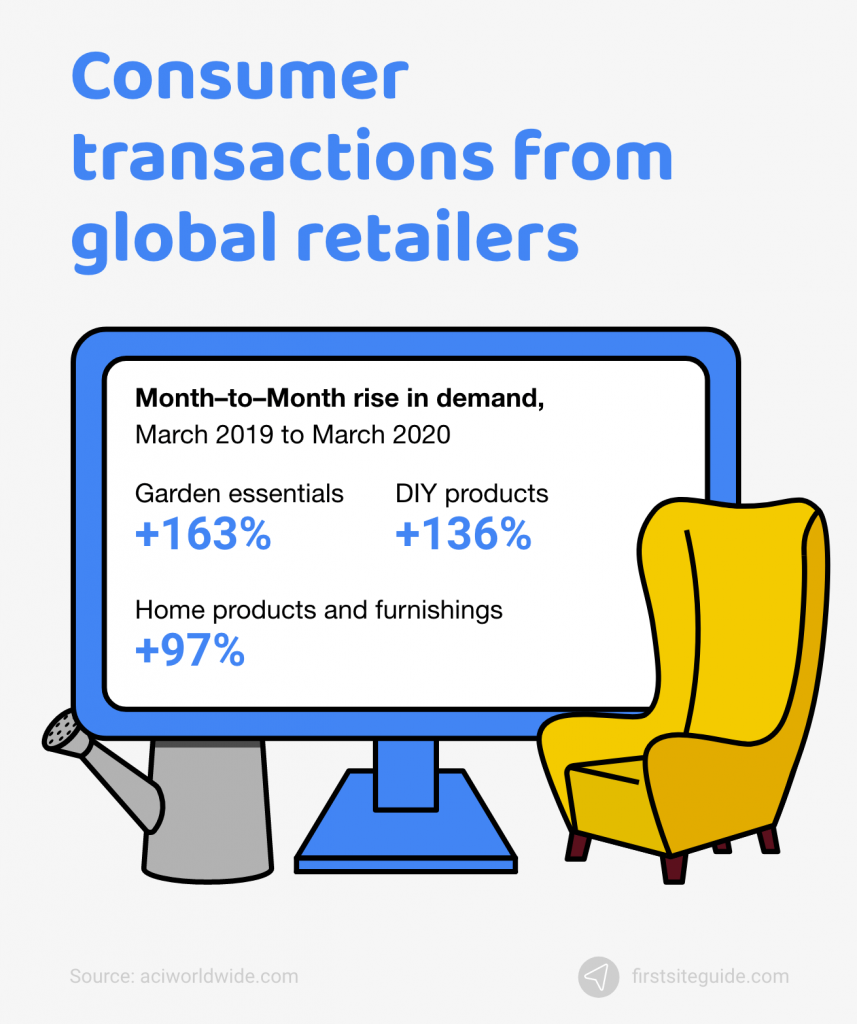
(Source: Apnews.com)
9. Online apparel sales increased by 34% while prices dropped 12%.
When people are home alone, they like spending money out of boredom. Another thing people like is feeling beautiful and comfortable in their skin, which has increased online apparel sales by about 34%. In addition, the prices of online apparel have dropped by about 12%.
(Source: Adobe.com)
10. Pajama sales are up by 143% as are most stay-at-home clothes.
While on the topic of comfort, pajama sales seem to be up by a whopping 143%. Other clothes such as T-shirts increased sales by about 47%, while things like jackets have dropped by about 33%.
(Source: Adobe.com)
11. The U.S. had an increase of 110% in daily online sales in April 2020.
Online sales are convenient, which has especially come to light while the pandemic was wreaking havoc worldwide. In fact, in April 2020 there was an increase in daily online sales by about 110%.
(Source: Adobe.com)
12. The European and North American average consumers’ intent to shop online dipped down between 30% and 40%.
However, in a contrasting piece of data, shopping intent by consumers in Europe and North America dropped down between 30% to 40%, especially in the fashion and luxury sectors – most likely due to the harsh quarantine measures in wealthier areas.
(Source: Mckinsey.com)
13. Consumers plan to spend 30% to 50% more on things such as groceries.
While consumers aren’t buying Rolex watches, their grocery lists have grown quite a bit. Consumers now plan to spend 30% to 50% more on groceries, household supplies, personal care items, and home entertainment.
(Source: Mckinsey.com)
14. 48.7% of consumers who purchase things online are female.
Women have a bad reputation for supposedly going on shopping sprees, but the numbers show otherwise. Only about 48.7% of people who purchase things on the internet are female, making males the majority gender in online shopping.
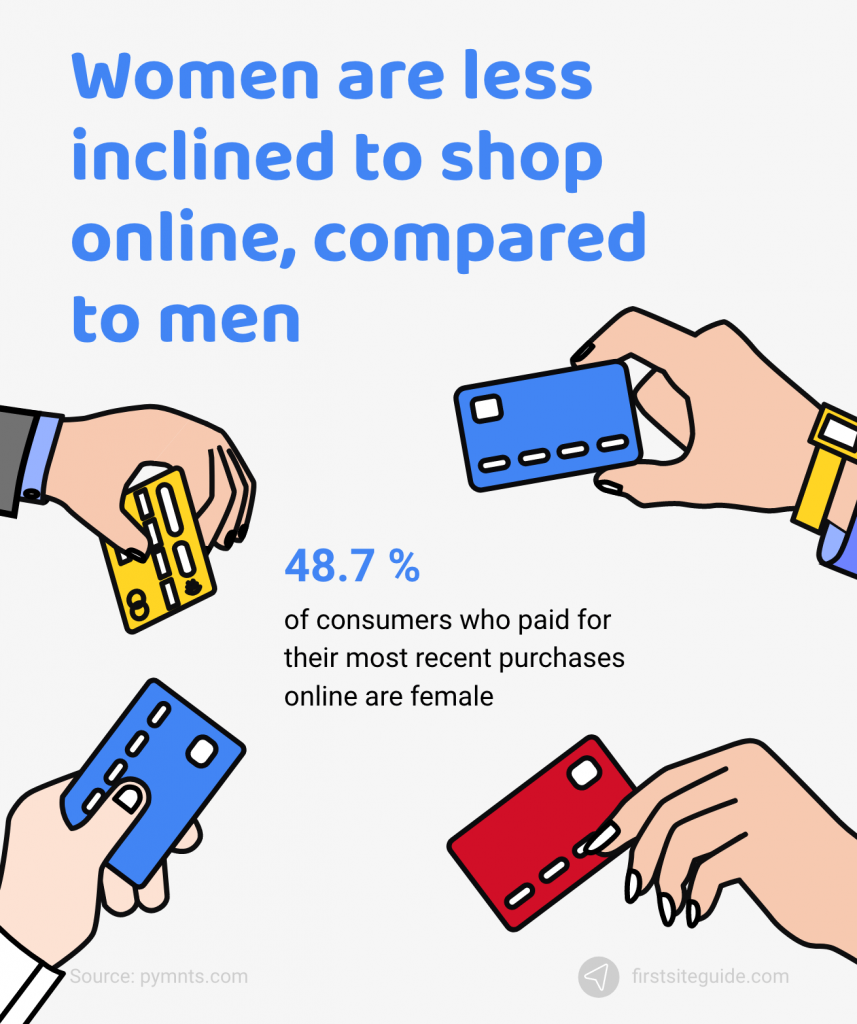
(Source: Pymnts.com)
15. The average age of an in-store shopper is 44.8 years old, while the average for online shoppers is 38.9 years.
Most people who shop on the internet are anywhere from 30-39 years old, with the average age of the internet shopper being about 38.9 years. In comparison, the average age of a brick-and-mortar shopper is about 44.8 years old.
(Source: Pymnts.com)
16. 70% of small-to-mid-sized businesses (SMBs) are investing more in their digital presence.
If you want to know how a local economy is doing and the future trends of businesses, you should always look at the small guys. Small businesses are usually the quickest to adapt to new things. Looking at them now shows that about 70% of SMBs are investing more in their digital presence, actively showing that the future of business is on the digital landscape.
(Source: Pymnts.com)
17. About 51% of all businesses interact more with their customers and clients online.
Online shopping has removed customer interaction from the equation. These days, with A.I., front desks, and CMS solutions, online businesses are once again interacting with their customers. About 51% of all businesses report that they’ve experienced a higher volume of online interactions with their customers in 2020.
(Source: Dataforgood.fb.com)
18. 35% of small-to-mid-sized businesses actively encourage the use of digital payment methods.
SMBs are also faster to adopt digital payments, with about 35% of them actively encouraging digital payment methods instead of cash and cards.
(Source: Dataforgood.fb.com)
19. 36% of all small or personal businesses are making their sales on the internet.
Small businesses pop up and go away in record time, but those who stay have a chance at becoming the next big thing. It’s important to note that most people these days aren’t opening up shops, they’re starting their online stores. About 36% of all personal businesses are making sales over the internet.
(Source: Dataforgood.fb.com)
20. Over 50% of small business owners are expecting a lot more online sales after the pandemic concludes.
The pandemic has ruined many small businesses, but small business owners that have persisted through the pandemic expect an increase in online sales after the pandemic passes. Most of them have taken the time to improve their digital shopping experience.
(Source: Pymnts.com)
Internet business statistics in the future
Those of us who have had the pleasure of spending our days rummaging through early internet data can tell you that things have changed a lot.
Not everything was branded back in the early days. Users had absolute and total freedom, and exploring what the web had to offer wasn’t nearly as easy or censored as it is today. Let’s take a look at some internet statistics that show where this brave online world is headed in the coming years.
21. Global eCommerce retail sales are expected to reach $4.9 trillion by 2021.
eCommerce is pretty big, and it’s only getting bigger as time goes by. The global eCommerce market is expected to reach a mind-boggling 4.9 trillion USD by the end of 2021.
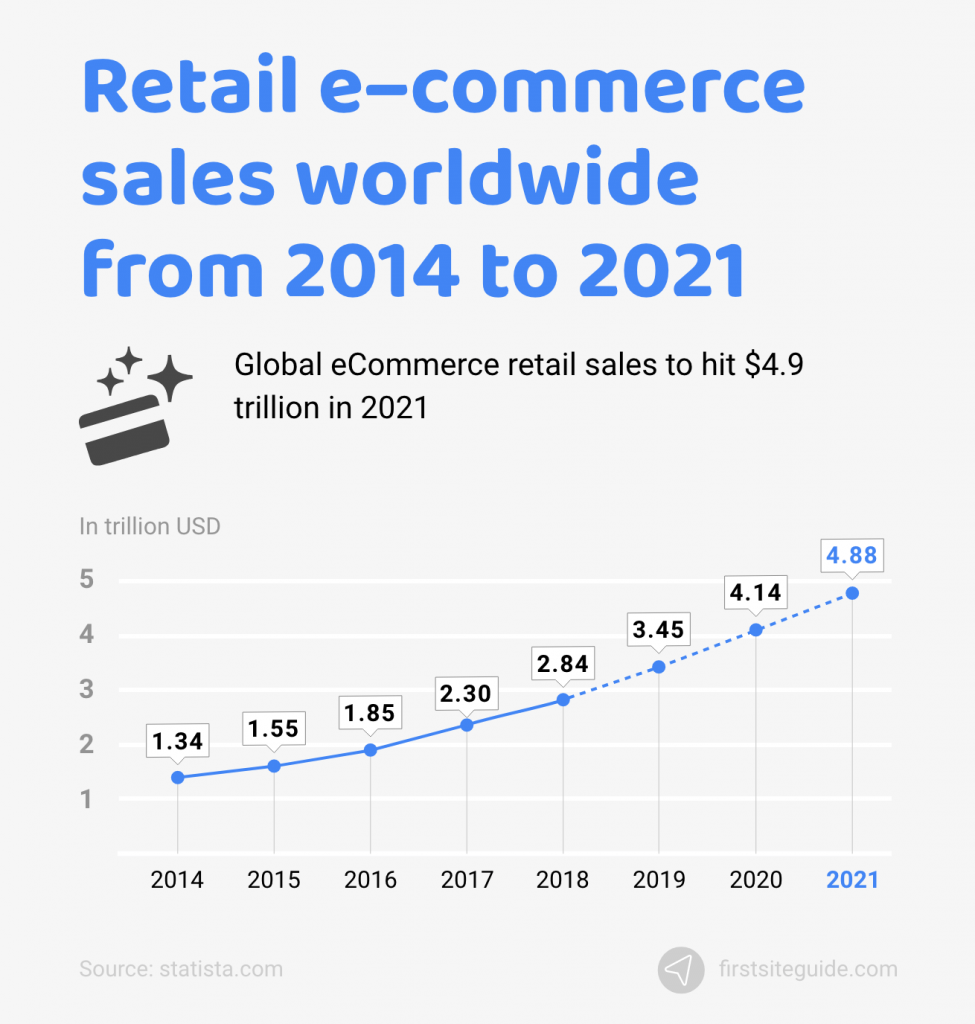
(Source: Statista.com)
22. Global eCommerce retail sales are expected to account for 17.5% of total retail sales.
Traditional retail is slowly becoming a thing of the past, as digital retail and online stores are taking over. Global eCommerce retail sales are expected to reach about 17.5% of the total retail market by 2021.

(Source: Statista.com)
23. 73% of customers use multiple channels and websites for their shopping.
Studies show that about 73% of all customers who shop online use more than one channel for their shopping. Customers essentially browse through several different websites before deciding on which product or service to purchase.
(Source: Hbr.org)
24. 35% of people say that trying a product online through Augmented Reality (AR) would make them shop more.
AI and A.R. are changing industries left and right, and online business has yet to adapt. There’s a rising demand for augmented reality solutions in industries such as retail and eCommerce. Around 22% of people say that they would prefer online shopping if they could try the product before purchasing it.
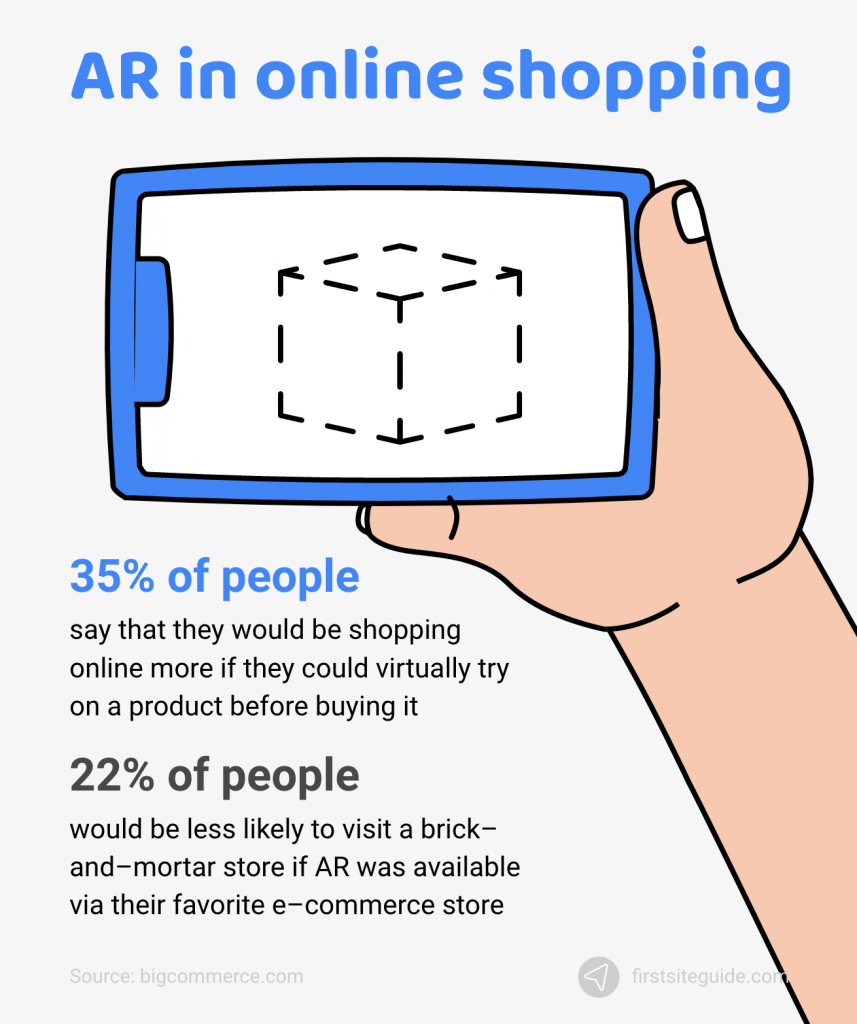
(Source: Bigcommerce.com)
25. Artificial intelligence is making its way into eCommerce.
AI technology has long been a part of the internet, and it’s always finding new ways to be useful. One of the more interesting uses of AI is in eCommerce, where it’s tasked with learning about consumers. AI enables highly personalized experiences for customers, offers relevant product suggestions, and analyzes customer purchasing habits to make their journey that much more streamlined.
(Source: Revenueriver.co)
26. Hybrids of eCommerce and social media are on the rise.
As the internet grows, the line between existing platforms, media, and technologies becomes more blurred. Social media platforms such as Facebook are slowly adding eCommerce elements to their websites, allowing customers to purchase things without ever leaving the social media platform.
(Source: Revenueriver.co)
27. Big Data is going to change personalization forever.
Big data is one of the most buzzing technologies alongside AI and AR, and it will play a monumental role on the internet of the future. With big data, personalized experiences can become that much more sophisticated and, well, personal.
(Source: Kensiumsolutions.com)
28. The United States’ share of the total global retail market is projected to decrease by as much as 16.9% in 2020.
The U.S. used to be the leading country when it came to retail, but its dominance is slowly diminishing. America’s global market share is projected to decrease by about 16.9% in 2020, and it’s uncertain what the future holds.
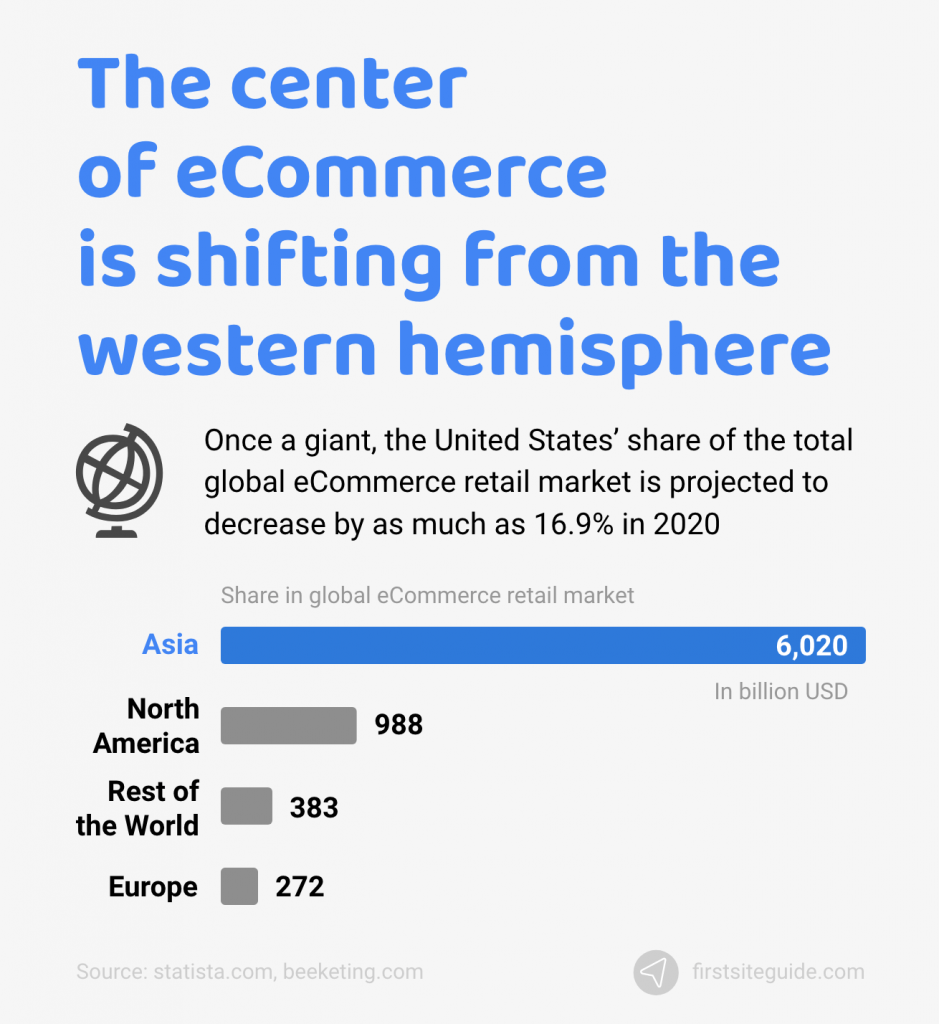
(Source: Statista.com)
29. 33% of people end their relationship with a business due to a lack of personalization in their shopping experience.
People like personalization, and that’s a fact. They don’t just like personalized shopping experiences, they despise non-personal shopping experiences. About 33% of all online shoppers don’t return to websites that don’t provide a personalized shopping experience.
(Source: Shopbase.com)
30. The mobile market hosted 70% of online traffic at the end of 2018.
The world of online business isn’t the only one that’s booming. Mobile phones are skyrocketing in popularity, and they’ve slowly been stealing thunder from desktop devices over the last few years. The mobile market accounted for 70% of all online traffic by the end of 2018 and the beginning of 2019.
(Source: 10trends.com)
31. Voice-powered shopping is estimated to surpass the $40 billion mark across the U.S. and U.K. by 2022.
Surprisingly, voice-powered shopping is also slowly rising in popularity. Experts expect it to pass the 40 billion dollar mark across the U.S. and U.K. as early as 2022.
(Source: Techcrunch.com)
32. 70% of people are firm believers that digital payment methods will surpass cash and cards by 2030.
While cryptocurrencies might be the future of finance, digital payment methods are most definitely the future of payments. About 70% of people are firm believers that digital payment methods will overtake traditional paper money and cards by 2030.
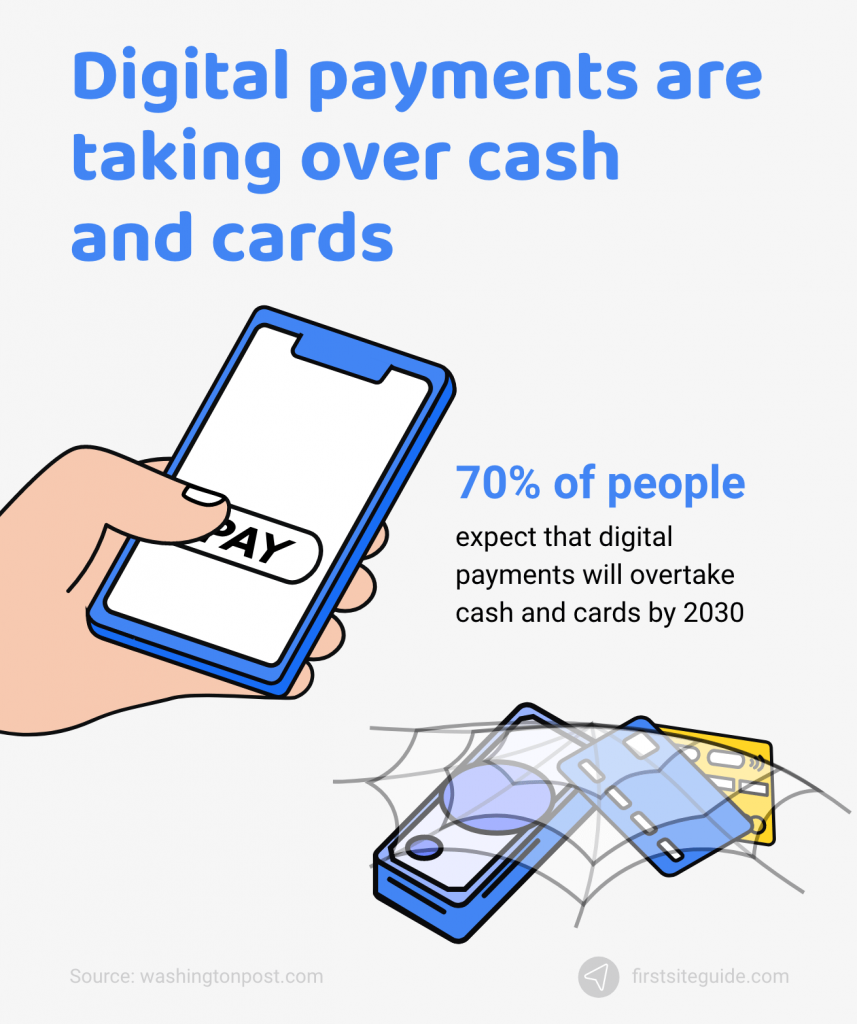
(Source: Washingtonpost.com)
Conclusion
The digital world never ceases to impress. With petabytes of data being uploaded every day, it’s safe to say that the internet is a lot like the universe – it keeps expanding and evolving. It’s interesting to think about just how much of these vast quantities of data are business tools, someone’s livelihood, or even promising inventions that will reshape the world as we know it.
It’s certain that as the online world grows, so do the businesses that call it home – and it’s just a matter of time until most businesses move to their new digital home.

Online business has been on its exponential phase during the pandemic. Affiliate marketing is a notable business that has really grown because upcoming influencers use their platforms to market the products their selling.
Online business is the next big thing for sure.